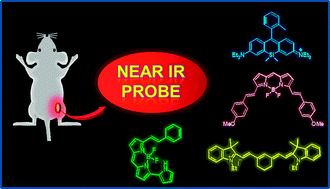Recent progress in the development of near-infrared fluorescent probes for bioimaging applications
Abstract
Near-infrared (NIR) fluorescent dyes have emerged as promising modalities for monitoring the levels of various biologically relevant species in cells and organisms. The use of NIR probes enables deep photon penetration in tissue, minimizes photo-damage to biological samples, and produces low background auto-fluorescence from biomolecules present in living systems. The number of new analyte-responsive NIR fluorescent probes has increased substantially in recent years as a consequence of intense research efforts. In this tutorial review, we highlight recent advances (2010–2013) made in the development and applications of NIR fluorescent probes. The review focuses on NIR fluorescent probes that have been devised to sense various biologically important species, including ROS/RNS, metal ions, anions, enzymes and other related species, as well as intracellular pH changes. The basic principles involved in the design of functional NIR fluorescent probes and suggestions about how to expand applications of NIR imaging agents are also described.


 Please wait while we load your content...
Please wait while we load your content...